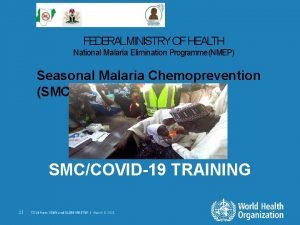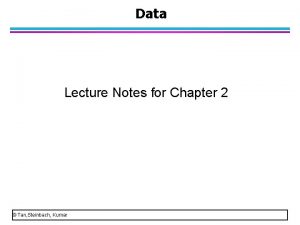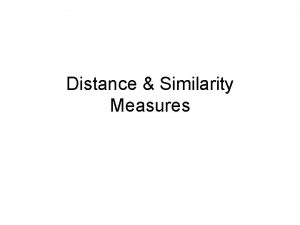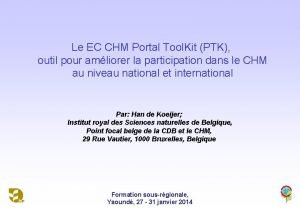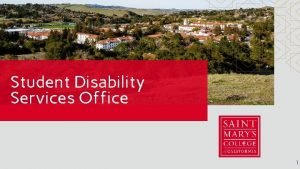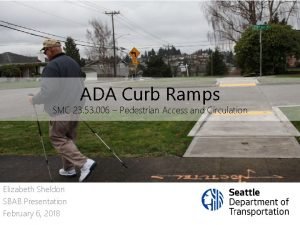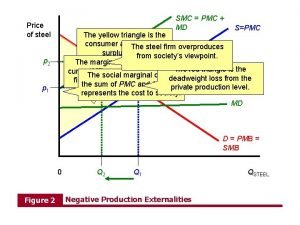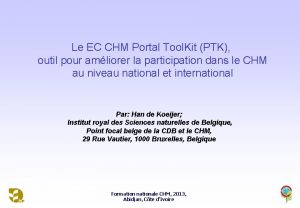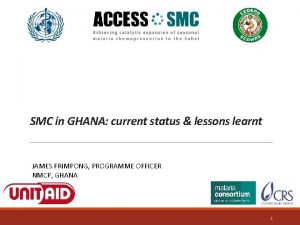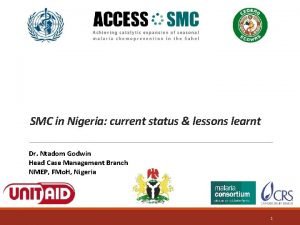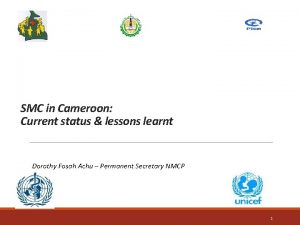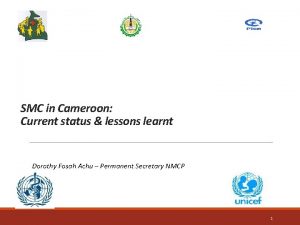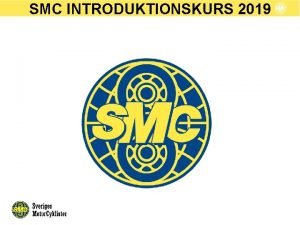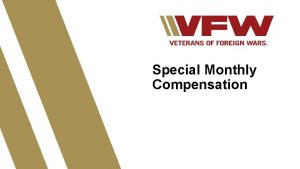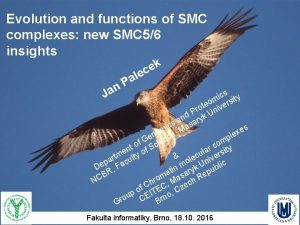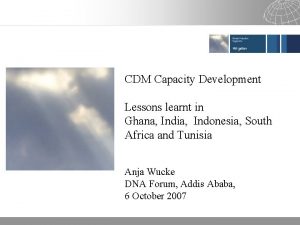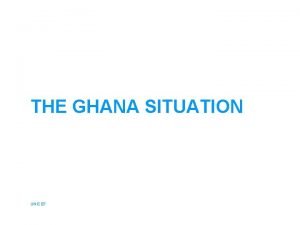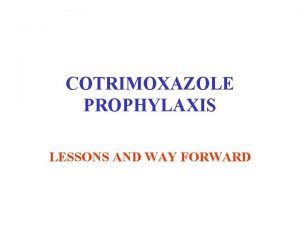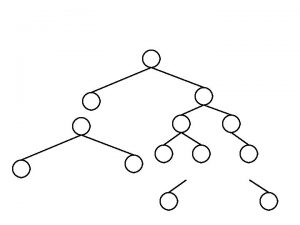SMC in GHANA current status lessons learnt JAMES
















- Slides: 16

SMC in GHANA: current status & lessons learnt JAMES FRIMPONG, PROGRAMME OFFICER NMCP, GHANA 1

GHANA: operational map 2015 Implementation ØUpper West Region (11 Districts) ØOperational funds provided by the Global Fund ØMedicines provided by DFID ØDoor-to-Door Approach ØTrained Community Volunteers Ø 4 Rounds of dosing 2

GHANA: operational map 2016 Implementation ØUpper West and Upper East Regions (11+13 Districts) ØOperational funds provided by the Global Fund ØMedicines provided by DFID ØDoor-to-Door Approach ØTrained Community Volunteers Ø 2 Rounds of dosing 3

Ghana: Funding map Partner/Districts covered 2016 2017 2018 Comments Number Eligible Districts* 24 24 24 All the districts in UE&UW The Global Fund 24 24 - GF provided operational funds and medicines DFID 11 24 - Procured the medicines for 2015 and 2016 Govt 24 24 24 Total funded 24 24 0 Unfunded 0 0 24 * By WHO criteria 4

Ghana: Targets & coverage Target number of children Administrative coverage results Severe Adverse Events reported 2015 2016 3 -11 months 24, 685 61, 128 23, 253 45, 010 12 -59 months 123, 423 305, 639 116, 264 258, 009 Total 148, 107 366, 767 139, 517 303, 019 152 313 Other comments: Specifically, this represents 70% of targeted children in 2016 as against 94. 2 % in 2015 5

GHANA: Lessons learnt Training - I Numbers Trained 2015 2016 Comments Trainers 30 64 Supervisors 280 652 Health Facility Workers 325 780 Community Health Workers 2500 5300 These include National, Regional and District level staff and it is cumulative for the two years. Training cascades Public announcers and other mobilisation actors 14 30 Total trained 3, 149 6, 826 6

GHANA: Lessons learnt Training – II (max 1 page + 1 page with sample pictures if appropriate) Training was done in a cascading mode, national-regional-district-subdistrict/community This helps to train more people in a shorter time However, the quality of training reduces down the line Impact of the training reflects in the volunteer performance Solution Supervision by national trainers helps to improve performance of trainers Use of pictorial job aides helps improve understanding Involvement of regional and district staff creates a sense of ownership staff 7

8

GHANA: Lessons learnt Door-to-Door approach was used in all instances, fixed approach gives impression of the usual facility based services, care givers choose to go at will and may prolong dosing scheduleØ This helped to ensure maximum coverage in the given period Ø It helps improve on other disease surveilance Ø Community members did not have to travel, no excuses of raining, etc Ø Volunteers chose flexible times to ensure 9

GHANA: Lessons learnt Delivery approaches – II Protective clothing for the Volunteers-eg rain coats, wellington boots Torch lights, plastic bags, zip-locked plastic envelopes to hold medication etc These should be factored into the resource mobilization Need to be budgeted for Could be considered as part of volunteer motivation 10

GHANA: Lessons learnt Eligibility and referrals Age determination must be cross-checked with the child’s health record books (Road to Growth) There is the need to thoroughly question the child’s health status and medication history Complete explanation of the exercise and its benefits is very important The risk of taking the doses without considering existing medication should be well explained to caregivers Supervisors can play a leading role by reviewing the child health records if available Ineligible children due to ill health should be referred to identified facilities with relevant diagnostic tools and personnel to manage All health facilities were told to manage ADRs free of charge 11

GHANA: Lessons learnt PV and safety monitoring Pharmacovigilance was implemented together with the FDA Teams were formed around FDA trained Institutional Contact Persons Volunteers were given instructions to report any ADR to their supervisors (HWs) who helped complete the ADR forms All ADR forms were sent to the Regional FDA office for transmission to Accra A major challenge is differentiating regular occurrences such as vomiting or spitting from real ADR Misunderstanding ADR to be only life threatening conditions These result in under-reporting of ADRs 12

GHANA: Lessons learnt Monitoring, supervision & evaluation of reach Tools provided in the WHO Field Guide were adopted, modified and used Periodic review was necessary to achieve final tools Daily meeting with volunteers was helpful in identifying difficult issues for addressing To ensure that each child receives the 4 cycle dose, the same register is used during a round To verify parents administer the dose, volunteers inspect the blister and conduct key informant interviews with neighbours District Malaria Focal Persons transmitted daily coverage to the Regional office, this helped identify areas in need of attention and additional support 13

Country XX: Lessons learnt Key messages / recommendations / conclusions (max. 2 pages) ØSocial/community mobilization is essential for acceptance and success ØEarly identification of key stakeholders is very important-partners go beyond actors in the health service; ØProcurement of SPAQ must be initiated early-8 mths to 1 year ahead! ØSupervisors must be well trained and committed ØVolunteers should be sufficiently motivated-financially and morally ØThe challenges of SMC implementation are enormous but the benefits make it worth the efforts 14

ACKNOWLEDGEMENT GFATM DFID GOG The WHO-Country Office Sub-Regional Partners-WAHO, W/CARN The Regional Health Directorates-UWR &UER FDA National and Regional Offices 15

THANK YOU 16
 Smc house marking
Smc house marking Smc tool
Smc tool Smc vs jaccard
Smc vs jaccard Similarity and dissimilarity measures in data mining
Similarity and dissimilarity measures in data mining Smc ptk
Smc ptk Smc scholars classes
Smc scholars classes Mass effect title
Mass effect title Smc technology sdn bhd
Smc technology sdn bhd Student disability services (sds) office
Student disability services (sds) office Smc
Smc Smc 23
Smc 23 Smc pmc
Smc pmc Chmportal
Chmportal Andromeda smc
Andromeda smc Line current and phase current
Line current and phase current Mesh current method with current source
Mesh current method with current source Ceramic composition resistors
Ceramic composition resistors
